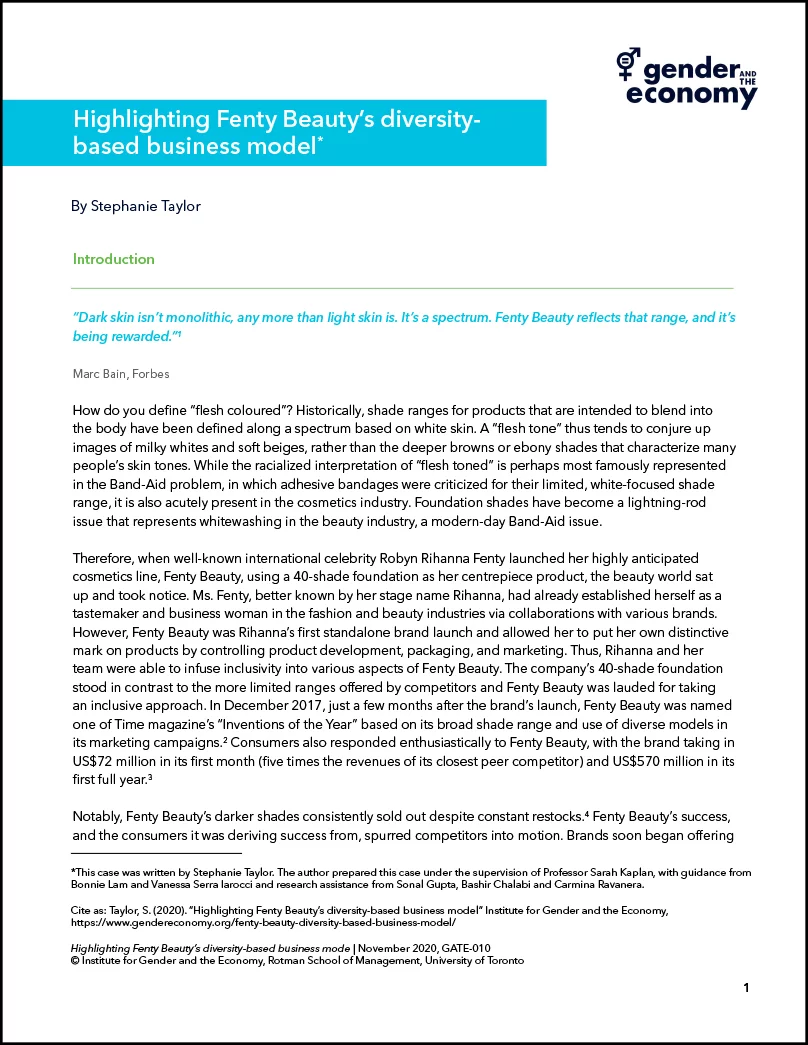Overview
Fenty Beauty is an inclusive cosmetics company created by international celebrity Rihanna in partnership with LVMH, an exclusive luxury conglomerate. The brand has been a resounding success and is most recognized for the “Fenty Effect”, a trend in which competitors began offering more inclusive cosmetic products in response to Fenty Beauty’s successful 40-shade foundation line. Fenty Beauty is a unicorn in the beauty industry, largely due to its prioritization of diversity and inclusion.
Course Topics:
- BIPOC Diversity & Inclusion
- Marketing
- Supply Chain Management
- Product Development & Pricing
- Business Design
- Corporate Governance
Introduction:
How do you define “flesh coloured”? Historically, shade ranges for products that are intended to blend into the body have been defined along a spectrum based on white skin. A “flesh tone” thus tends to conjure up images of milky whites and soft beiges, rather than the deeper browns or ebony shades that characterize many people’s skin tones. While the racialized interpretation of “flesh toned” is perhaps most famously represented in the Band-Aid problem, in which adhesive bandages were criticized for their limited, white-focused shade range, it is also acutely present in the cosmetics industry. Foundation shades have become a lightning-rod issue that represents whitewashing in the beauty industry, a modern-day Band-Aid issue.
Therefore, when well-known international celebrity Robyn Rihanna Fenty launched her highly anticipated cosmetics line, Fenty Beauty, using a 40-shade foundation as her centrepiece product, the beauty world sat up and took notice. The company’s 40-shade foundation stood in contrast to the more limited ranges offered by competitors and Fenty Beauty was lauded for taking an inclusive approach. In December 2017, just a few months after the brand’s launch, Fenty Beauty was named one of Time magazine’s “Inventions of the Year” based on its broad shade range and use of diverse models in its marketing campaigns. Consumers also responded enthusiastically to Fenty Beauty, with the brand taking in US$72 million in its first month (five times the revenues of its closest peer competitor) and US$570 million in its first full year. Notably, Fenty Beauty’s darker shades consistently sold out despite constant restocks, a phenomenon that spurred competitors into offering increased shade ranges in what became known as the “Fenty Effect”. Three years later, Fenty Beauty continues to experience rapid growth and Rihanna has launched a fashion empire that includes skincare, lingerie, and a luxury fashion line all offered under various Fenty brand names. These newer brands similarly feature the inclusive, playful approach first developed at Fenty Beauty, proving that inclusivity is a winning business model and no longer just a corporate afterthought.
View and download the full case study
__________________________
This case was written by:
This case was written by Stephanie Taylor. The author prepared this case under the supervision of Professor Sarah Kaplan, with guidance from Bonnie Lam and Vanessa Serra Iarocci and research assistance from Sonal Gupta, Bashir Chalabi and Carmina Ravanera.








